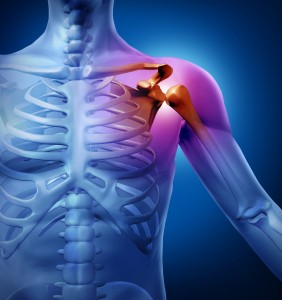By: Sarah McWilliams
A dislocation occurs when the bones that should be connected at a joint separate. Most of the joints in your body are at risk including shoulders, knees, hips, fingers and even toes. The dislocation could damage surrounding areas such as ligaments, blood vessels and nerves.
Who’s at risk?
This is one injury that is not age, gender, or sport specific. Anyone who falls or has a sudden impact to a joint is at risk for a dislocation. Since the impact typically needs to high force to cause a dislocation, it is not as common as other sports injuries.
What are the symptoms?
Although severe pain is typically associated with a dislocation, there are typically specific visual cues as well. If you compare the joint to its counterpart, you will see a significant difference. There may also be a bulge near the joint and you will not be able to move it.
The pain associated with a dislocation will remain until a health care professional “reduces” or puts the joint back into place. Although there will be significant pain associated with the reduction, the pain should start subsiding over the next several weeks.
 How do you diagnose this type of injury?
How do you diagnose this type of injury?
It’s typically fairly obvious when you have a dislocation just by looking at the joint and the severe pain will probably tip you off as well. However, your doctor will take an X-ray of the area to ensure there are no broken bones as well, which could be damaged further when the dislocation is reduced.
What are the treatment options?
A medical professional must reduce the injury putting the bones back into place. Because this can be a painful process, sometimes your health care professional will use a sedative or even general anesthesia before placing the bones. Once the bones are back in place, a splint or bandage is used during the healing process.
Surgery may also be necessary if the dislocation results in a torn ligament. In knee dislocations, the ACL is also commonly torn and surgery will be required to repair the torn ligament with extensive physical therapy to help heal the entire area.
 How long is the recovery period?
How long is the recovery period?
As long as there are no breaks in the surrounding bones or ligament tears, a dislocation, when properly treated, should heal in 3-6 weeks. Unfortunately, once you have dislocated a joint, it’s more vulnerable in the future.
Commonly mistaken injuries
There are almost always visual cues alerting someone of a dislocation, however, sometimes fractures can be mistaken as a dislocation. Knee dislocations are also commonly confused with partial dislocations, where the knee gives out, however in partial dislocations known as subluxation, the knee returns into place on its own and is much less severe than a full dislocation.
 ATLX The only sports entertainment television and digital media network fully devoted to everyday athletes, athletic lifestyle and athletic culture.
ATLX The only sports entertainment television and digital media network fully devoted to everyday athletes, athletic lifestyle and athletic culture.





